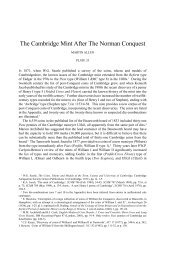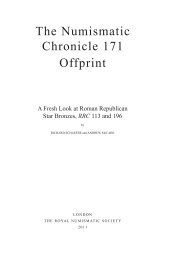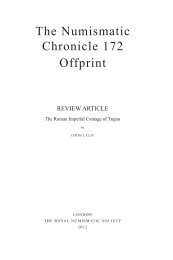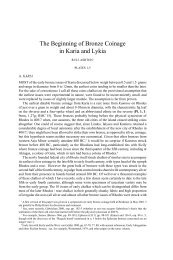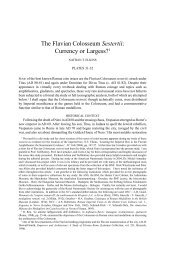Iolkos and Pagasai: Two New Thessalian Mints* - Royal Numismatic ...
Iolkos and Pagasai: Two New Thessalian Mints* - Royal Numismatic ...
Iolkos and Pagasai: Two New Thessalian Mints* - Royal Numismatic ...
Create successful ePaper yourself
Turn your PDF publications into a flip-book with our unique Google optimized e-Paper software.
IOLKOS AND PAGASAI 25<br />
A die-flaw resembling a small globule on the only known reverse die occurs in<br />
the upper left field of all the coins.<br />
The two obverse dies appear to be more or less contemporary since they are<br />
clearly by the same h<strong>and</strong> <strong>and</strong> the reverse die with which they are coupled shows<br />
the same degree of wear with both. The flans of all the coins are very thick,<br />
resembling those of other <strong>Thessalian</strong> coins dated to the first half <strong>and</strong> middle of<br />
the 4th century BC. The die-axes are irregular <strong>and</strong> some of the coins are poorly<br />
centred. The diameter of all coins is consistent <strong>and</strong> does not exceed 12 mm.<br />
With an average weight of 2.03g our coins seem to be chalkoi, denomination C<br />
in the analysis of Papaevangelou-Genakos <strong>and</strong> the smallest bronze minted in<br />
Thessaly. 9<br />
The letters of the legend are not particularly revealing for dating purposes, but<br />
are consistent with the Ionian alphabet of the 4th century BC, having, for<br />
example, a fairly large omega. The ethnic������������������� is known from the<br />
written sources (Stephanos Byzantios, s.v.��������� <strong>and</strong> also from inscriptions. 10<br />
The head of Artemis has a bulbous eye with thick eyelashes set at an angle <strong>and</strong><br />
a markedly arched eyebrow, a low forehead, an almost triangular jutting chin,<br />
<strong>and</strong> a flat cheek. As we shall see, it bears some similarity to the head of Apollo<br />
<strong>Pagasai</strong>os on the coins of <strong>Pagasai</strong>. For dating purposes the most important<br />
feature is the hair, which is in the so-called melon style. This style appeared<br />
shortly before the middle of the 4th century BC, reached its peak of popularity<br />
during the 3rd century BC, but continued in use sporadically in sculpture,<br />
figurines, <strong>and</strong> coins. The style appears on the head of Ennodia on coins of<br />
Pherai issued under the tyrant Alex<strong>and</strong>er (369-358 BC) <strong>and</strong> in the name of the<br />
city in the second quarter of the 4th century BC, 11 <strong>and</strong> on the head of Artemis on<br />
the coins of Ekkarra. 12 In addition to these <strong>Thessalian</strong> mints, a similar style<br />
appears on the head of Artemis on coins of Orthagoreia 13 <strong>and</strong> of Philip II, both<br />
dated by Le Rider to around 342/341-329/328 BC, 14 <strong>and</strong> on the head of Artemis<br />
on the silver coinage of the Scythian king Ateas 15 during the second half of the<br />
4th century BC under the influence of the coins of Philip II. There are many<br />
parallels in sculpture <strong>and</strong> figurines. 16 Note in particular a grave relief from Agria<br />
9<br />
Papaevangelou–Genakos 2004, p. 47.<br />
10<br />
IG IX 2, 1109, l. 6.<br />
11<br />
Wartenberg 1994, pp. 151-6, Pl. 159, no. 15 (Alex<strong>and</strong>er); no. 8 (Pherae).<br />
12 Liampi 1998, pp. 417-39.<br />
13 Gaebler 1935, pp. 92-3, nos 1-3, Pl. 18, nos 21-3.<br />
14 Le Rider 1977, pp. 395-6, Pl. 43, nos 504-11 (Amphipolis II, B).<br />
15 SNG BM (Black Sea) 200; for a better preserved example, see <strong>Numismatic</strong>a Genevensis 1 (A.<br />
Baron, Geneva, 27/11/2000), no. 76.<br />
16 For example a Bear from Brauron (Themelis (-), p. 70, fig. 16 b), <strong>and</strong> a terracotta female<br />
figurine found in a grave near Nea Anchialos in Thessaly (Hourmouziadis – Asimakopoulou–Atzaka<br />
– Makris 1982, p. 65, fig. 35 (Hourmouziadis)).



